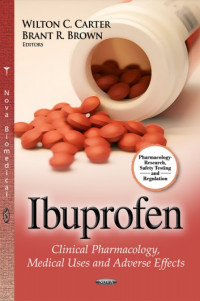
Electronic Resource
IBUPROFEN : CLINICAL PHARMACOLOGY, MEDICAL USES AND ADVERSE EFFECTS
618.9201 Newborn Infant, Neonates/Perawatan Bayi Baru Lahir, Neonatal
Kelaskan di sini neonatology/neonatologi
Neonatologi: ilmu kedokteran yang mempelajari tentang perawatan dan perkembangan bayi yang baru lahir
615 Pharmacology and Therapeutics/Farmakologi dan Terapi Farmakologi
Kelaskan di sini obat-obatan secara umum
Termasuk apotek
Gunakan untuk farmakologi dan terapi
Jangan gunakan untuk farmakologi umum saja; kelaskan di 615.1
Jangan gunakan untuk terapi umum saja; kelaskan di 615.5
Lihat juga 363.1 untuk program keamanan terhadap keracunan obat-obatan
Lihat juga 582.12 untuk apotek hidup
For the last few decades, emerging pollutants are the object of increasing public concern among scientists and society. These compounds, also known as contaminants of emerging concern, are chemicals that originate from industrial, agricultural and human activities, very often as consumer products and by-products used every day. Examples of this new class of pollutants include pesticides, solvents, flame retardants, nanoparticles, and pharmaceuticals (prescription and non-prescription human and veterinary compounds) and personal care products (PPCPs). A common characteristic to all of them is that they are not included in routine monitoring programs at a worldwide level, but have been added to the Candidates Contaminant List for prioritizing their regulation in the near future due to their occurrence, potential health effects, and ecotoxicity. Ibuprofen is among the most frequently reported active pharmaceutical ingredients in ambient monitoring studies worldwide, and the second most consistently detected one in finished drinking water at high concentrations (> 1 ppb). This is due to the large consumption of this popular analgesic allied with the poor efficiency of conventional water treatment processes for its complete removal/degradation. Even though the amount of ibuprofen allowed in different sorts of water is not regulated at the moment, many efforts from the scientific community are currently being directed on its monitoring, removal and/or degradation. In fact, water is an essential resource for life in all ecosystems and so far little is known about the occurrence, fate, synergistic and longterm effects of active pharmaceutical ingredients and their metabolites following their end-use. This chapter aims to provide the current state of scientific knowledge regarding ibuprofen occurrence, fate and toxicological effects in water environments and aquatic organisms, as well as remediation technologies. The fate of ibuprofen during conventional water treatments is presented along with a review of recent advances of water treatment methodologies to control the occurrence of pharmaceuticals in water environments, focusing in their performance for ibuprofen mitigation. Besides reviewing the performance of treatment methodologies individually, hybrid processes, combining membrane filtration with biodegradation, adsorption and/or advanced oxidation processes, will be also addressed. Such hybrid technologies can effectively remove a large variety of micropollutants, which respond distinctively to each individual treatment process, and so rise as the key towards an effective water treatment system that allows to obtain effluents with high quality standards.
Ketersediaan
| EBK-00202 | 615.1/Wil-i | Perpus Pusat | Tersedia |
Informasi Detail
- Judul Seri
-
-
- No. Panggil
-
615.1/Wil-i
- Penerbit
- New York : Nova Science Publishers., 2013
- Deskripsi Fisik
-
418 hlm
- Bahasa
-
Indonesia
- ISBN/ISSN
-
978-1-62618-660-6
- Klasifikasi
-
615.1
- Tipe Isi
-
text
- Tipe Media
-
e-book
- Tipe Pembawa
-
-
- Edisi
-
-
- Subjek
- Info Detail Spesifik
-
Electronic Version
- Pernyataan Tanggungjawab
-
-
Versi lain/terkait
Tidak tersedia versi lain
Lampiran Berkas
Komentar
Anda harus masuk sebelum memberikan komentar
 Karya Umum
Karya Umum  Filsafat
Filsafat  Agama
Agama  Ilmu-ilmu Sosial
Ilmu-ilmu Sosial  Bahasa
Bahasa  Ilmu-ilmu Murni
Ilmu-ilmu Murni  Ilmu-ilmu Terapan
Ilmu-ilmu Terapan  Kesenian, Hiburan, dan Olahraga
Kesenian, Hiburan, dan Olahraga  Kesusastraan
Kesusastraan  Geografi dan Sejarah
Geografi dan Sejarah